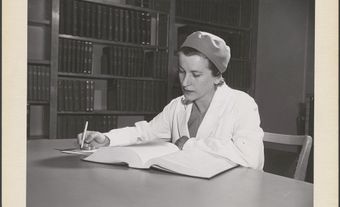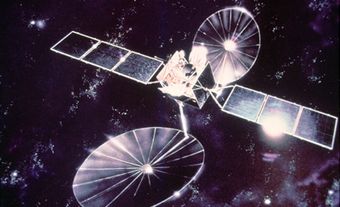Yvonne Madelaine Brill (née Claeys), rocket scientist (born 30 December 1924 in St. Vital, MB; died 27 March 2013 in Princeton, New Jersey). Yvonne Brill is known for her contributions to the advancement of rocket propulsion systems and designing rocket systems for space missions to the moon while keeping modern satellites in orbit. Although she was barred from pursuing an engineering degree because of her gender, Brill’s pioneering innovations are world-renowned.
Early Life and Education
Yvonne Brill (née Claeys) was born on 30 December 1924 in St. Vital, Manitoba (now part of Winnipeg). Her parents were immigrants from Belgium. The adventures of Amelia Earhart, the first woman to pilot a plane across the Atlantic Ocean, inspired Brill to go to school. She tried to enroll in the University of Manitoba’s engineering program when she was 18, but she was denied. A mandatory summer camp for all engineering students did not have facilities for a woman, and the dean refused to change them to accommodate Brill.
Brill went on to pursue a degree in mathematics and chemistry, graduating at the top of her class at age 20. But, this initial snub left her with a lifelong passion for encouraging women in the sciences. It also made her resolute in the face of gender-based discrimination — something she would experience frequently throughout her career. “You just have to be cheerful about it and not get upset when you get insulted,” said Brill.
Early Career and Rocket Science
After graduating from the University of Manitoba, Yvonne Brill moved to Los Angeles to work for Douglas Aircraft. Her first job involved calculating trajectories for a potential satellite. She is believed to be the only woman who worked on rockets in the United States in the 1940s, which was part of its appeal to Brill. “I reckoned they would not invent rules to discriminate against one person,” she said. However, she did not find the purely theoretical work satisfying and preferred to work on practical applications.
While working toward her master’s degree in chemistry at the University of Southern California, Brill took a job at the Marquardt Corporation. There she perfected a type of rocket fuel system that led to the first successful test of a US-made ramjet, a type of missile propulsion technology. (See also Canadian Aerospace Industry).
After obtaining her master’s degree, she married research chemist William Brill in 1951. In 1952, the couple moved to the east coast of the United States for his work.
Development of the Electrothermal Hydrazine Thruster (EHT)
Shortly after moving, Yvonne Brill began working for the RAND Corporation, where she researched and developed data on rocket fuel combinations that became the American standard for decades. In 1958, she stepped away from her job to raise her children. She worked part-time as a consultant, eventually returning to full-time work for RCA Astro in 1966. Her job involved working on the NOVA rockets that powered NASA’s Apollo missions to the moon. (See also Canadian Astronauts).
While there, Brill completed a project she had been working on in her own time for years. It was a new kind of engine that would become her most important contribution to rocket science: the electrothermal hydrazine resistojet, or electrothermal hydrazine thruster (EHT). Used primarily on geosynchronous satellites — satellites that need to stay in the same position relative to the earth, like communications satellites — it uses electricity to heat the rocket fuel hydrazine. Brill’s innovation allowed satellites to use fuel more efficiently, which allowed them to operate longer. It has been used to keep satellites in orbit since 1983 and it remains the industry standard. (See also Space Technology).
Brill finished her career with NASA. She oversaw the Space Shuttle Solid Rocket Program and served on the Aerospace Safety Advisory Panel. She was also involved in numerous National Research Councils related to space flight and exploration.
Significance and Legacy
In addition to creating the EHT, Yvonne Brill contributed to rocket systems that powered the first weather satellite, known as TIROS, the NOVA rockets that were used in NASA’s moon missions, the first upper-atmosphere satellite, the Mars Observer and the space shuttle.
Although she never officially studied engineering and never received her professional engineer’s license, Brill was made a fellow and has been recognized by numerous engineering associations, including the National Academy of Engineering (NAE), the Institute of Electrical and Electronics Engineers (IEEE) and the Society of Women Engineers (SWE).
Brill died on 27 March, 2013 in Princeton, New Jersey. Michael Griffin, president of the American Institute of Aeronautics and Astronautics, praised her as someone who combined “a clear vision of what the future of an entire area of systems should be with the ingenuity and genius necessary to make that vision a reality.” Professional organizations and acquaintances praised not only her work, but also her dedication to advancing women in scientific fields. Some noted that she had been writing letters of recommendation and submissions for awards up until her last days. In recognition of this work, the NAE established a lectureship in her name.
However, Brill’s official New York Times obituary sparked debate. The original draft praised her skills as a mother and cook — specifically citing her beef stroganoff — before mentioning her career as a rocket scientist. After a public outcry, the obituary was edited to highlight her career accomplishments first.
Honours and Awards
- Inductee, Women in Technology International Hall of Fame (1999)
- Distinguished Public Service Medal, NASA (2001)
- Inductee, National Inventors Hall of Fame (2010)
- National Medal of Technology and Innovation (2011)

 Share on Facebook
Share on Facebook Share on X
Share on X Share by Email
Share by Email Share on Google Classroom
Share on Google Classroom








